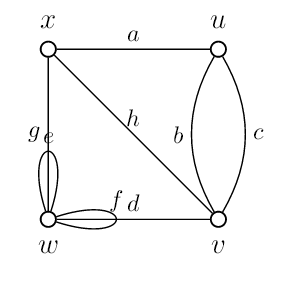سلام
با استفاده از دستور زیر:
\draw (D) to [out=18,in=-18,looseness=42]node[above]{$f$}(D);
بصورت زیر:
\documentclass{report}
\usepackage{tikz,amsmath}
\begin{document}
\tikzstyle{state}=[draw=black!50,fill=black,thick,scale=2.5]
\begin{tikzpicture} [inner sep=3 pt,scale=2.5,semithick,rounded corners,node distance=1cm]
\node[state](A) [scale=0.3,circle,black,fill=white]{};
\node[state](B) [right of=A,scale=0. 3,circle,black,fill=white] {} ;
\node[state](C) [ below of=B,scale=0. 3,circle,black,fill=white]{};
\node[state](D) [below of=A,scale=0.3,circle,black,fill=white]{};
\node[state](H) [right of=B,scale=0.6,xshift=10mm,circle,fill=white,draw=white,font=\tiny]
{$Closed \quad trail: ucvhxgwfwdvbu$};
\node[state](I) [below right of=B,yshift=-2mm,xshift=3mm,circle,scale=0.6,fill=white,draw=white,font=\tiny]{$Cycle: xaubvhx$} ;
\node[above of=A,yshift=-6mm,font=\large]{$x$};
\node[above of=B,yshift=-6mm,font=\large]{$u$};
\node[below of=C,yshift=6mm,font=\large]{$v$};
\node[below of=D,yshift=6mm,font=\large]{$w$};
\path(B) edge [] node[above]{$a$}(A);
\path(A) edge [] node[left]{$g$}(D);
\path(D) edge [] node[above]{$d$}(C);
\path(A) edge [] node[above]{$h$}(C);
\path(C) edge [bend left] node[left]{$b$}(B);
\path(C) edge [bend right] node[right]{$c$}(B);
\draw (D) to [out=18,in=-18,looseness=42]node[above]{$f$}(D);
\draw (D) to [out=72,in=108,looseness=42]node[above]{$e$}(D);
\end{tikzpicture}
\end{document}
خروجی:
